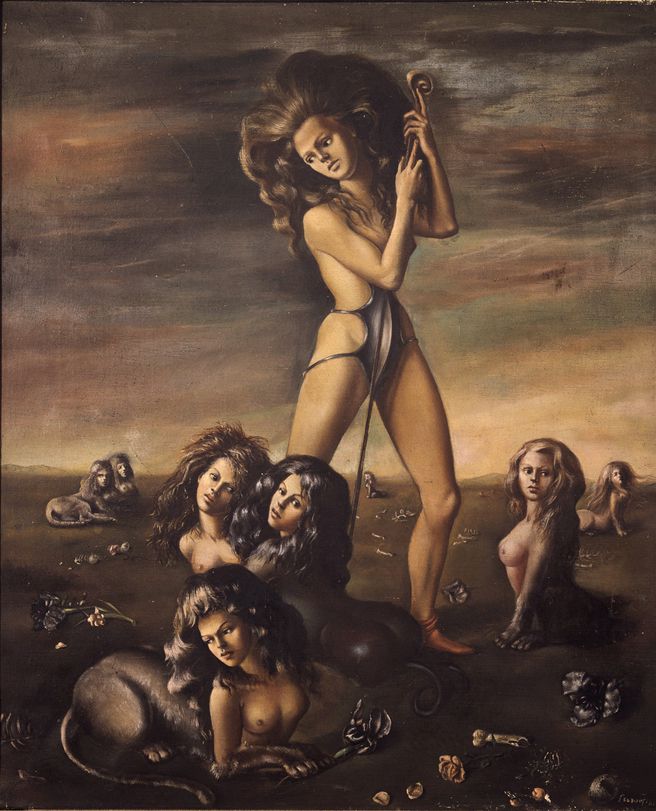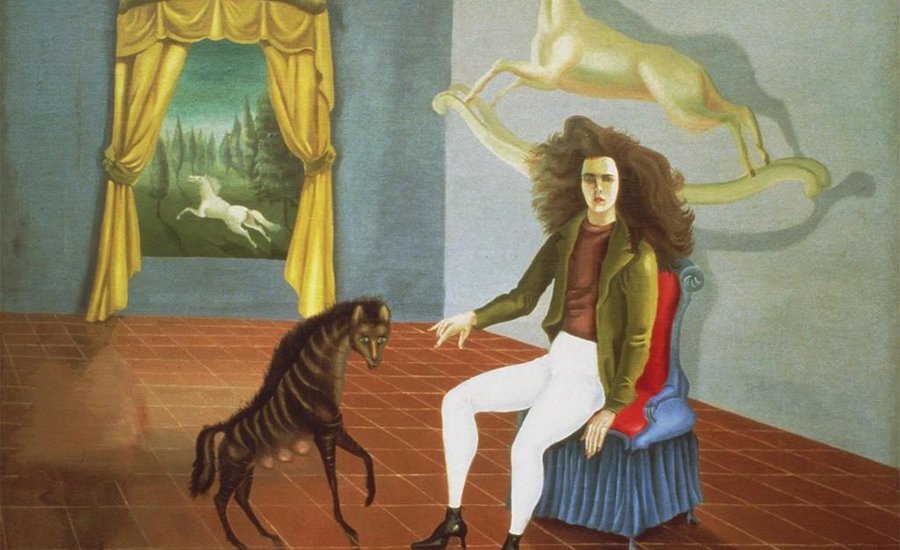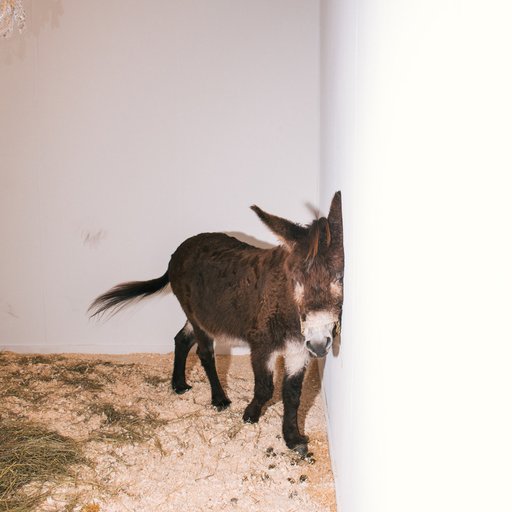In this new monthly series, "The Other Art History," we bring you the Other artists who have largely been excluded from our understanding of movements throughout art history.
In 1924, French writer and poet André Breton wrote an essay that would prove to define an emerging cultural movement. In his first Surrealist Manifesto, Breton culled philosophical ammunition from Freud and applied it to the creative practice, defining Surrealism as “psychic automatism in its pure state, by which one proposes to express the actual functioning of thought. Dictated by thought, in the absence of any control exercised by reason, exempt from any aesthetic or moral concern.” Equally defining of the movement and its sexism is a passage from Breton's second Surrealist Manifesto (1929), wherein he writes that, “the problem of woman is the most marvelous and disturbing problem in all the world.” (Breton was also a self-proclaimed fervent anti-fascist, and yet he banish fellow poet Rene Crevel out of his Surrealist clique due to Crevel’s homosexuality, asserting that the poet was corrupting the movement.) Despite Surrealism’s insistence on cultural liberation—Breton once wrote a manifesto with Trotsky calling for a “complete freedom of art”—it seems that right extended only to those who Breton seemed fit, namely heterosexual men.
Like much of history, our retrospective cultural narratives are predominantly told from the position of privilege, often to the exclusion of the oppressed and the marginalized, who are left to navigate a history that continually posits them as the Other. In this monthly series, "The Other Art History," we bring you those Other artists who have largely been excluded (or perhaps more accurately, occluded) from our understanding of movements throughout art history. Today, we'll review the (mostly) women of Surrealism, subverting the subverters, and throwing Salvador Dalí's comment about Leonor Fini—that she was "better than most, perhaps. But talent is in the balls,"—straight into a flaming pile of trash where it belongs.
LEONOR FINI
 La Bergère des Sphinx (1941). Image via Leonor Fini.
La Bergère des Sphinx (1941). Image via Leonor Fini.
The fact that Leonor Fini’s extraordinary legacy has been pretty much ignored might be one of art history’s biggest, and most disappointing moments. As a painter, Fini was an uncompromising visionary. She reversed gender roles, giving her women subjects unprecedented sexual prowess and agency, while the men were often depicted passive and androgynous. A 1942 painting of a reclining male nude is often cited as the first ever erotic nude portrait of a man painted by a woman. (Of the painting she said, "The man in my painting sleeps because he refuses the animus role of the social and constructed and has rejected the responsibility of working in society toward those ends.") Though she was a central figure in Paris’ Surrealist circle, she refused to kowtow to Breton’s authority and insisted that she and her work remain without categorization, requiring no validation from the likes of misogynists.
Notorious at the time for her daring, bohemian lifestyle, Fini lived life absolutely on her own flamboyant terms: “I have always loved, and lived, my own theatre.” Between 1946 and 1953 Fini attended 16 costume balls wearing spectacular outfits that always made headlines. “I used to arrive late, about midnight, light-headed with joy at being a royal owl, a large grey lion, the queen of the underworld.” She would arrive cross-dressed, or wearing nothing but white boots and a white feather cape, and experimented with dyeing her hair different shades of blue, orange, red, or gold. Living by her words, that “a woman should live with two men; one more a lover and the other more a friend,” Fini had a remarkable capacity for persuasion, convincing multiple husbands to allow her lovers to live with them… and their 17 Persian cats.
Not limited to the four sides of the canvas, Fini’s creative talent and prowess knew no bounds. She designed theatrical sets and costumes for the Paris Opera, George Balanchine’s ballet Palais de Crystal, Roland Petit’s company Ballets de Paris, and Federico Fellini’s icon of French New Wave cinema, 8 ½. She drew illustrations for Marquis de Sade’s Juliette and Histoire d’O, free of charge out of generosity and to support the work of her friend and peer. A photo of her swimming nude by Cartier-Bresson became the photographer's most expensive work ever sold at auction in 2007. Her first solo show was put on by Christian Dior, before he switched to fashion. Oh, and her work also inspired the art direction for Madonna's music video, Bedroom. She also had no formal artistic training and was basically self-taught, so why she still remains in obscurity is honestly baffling.
SUZANNE CÉSAIRE
 Portrait of Suzanne Césaire. Image via Repeating Islands.
Portrait of Suzanne Césaire. Image via Repeating Islands.
Since the surrealist manifesto was written by a poet, we felt compelled to include Suzanne Césaire despite the fact that she wasn't a visual artist. She was however, absolutely a Surrealist and a close friend to Breton who she met upon his visit to Martinique in 1941. A native of the French colonized Caribbean island, Césaire used Surrealism as a vehicle to explore anti-colonialism, describing the movement as “the tightrope of our hope,” and called for a Martiniquan surrealism: “Our surrealism will then deliver it the bread of its depths. Finally those sordid contemporary antinomies of black/white, European/African, civilized/savage will be transcended... Colonial stupidity will be purified in the flue welding flame."
Her work became critically influential on the post-colonial studies that would follow nearly 40 years later, as Afrosurrealism was rediscovered and given new life, but in 1943, much of Césaire’s work was overlooked, either overshadowed by her better-known husband Aimé Césaire or derided for promoting French affectation and aesthetics. Though largely unappreciated in her time, Césaire has since come to be recognized as a pioneer in the search for a distinct Martiniquan literary voice, integral to the development of Afro-surrealism, and acknowledged for her fierce wit and intellectual integrity. Her dictum, "La poésie martinique sera cannibale ou ne sera pas" [Cannibal poetry or nothing], an anti-colonial appropriation of a surrealist trope, says it all.
 Object (Dejeuner en Fourrure) (1936). Image via Ineart.
Object (Dejeuner en Fourrure) (1936). Image via Ineart.
A stand-alone exception to the boys club of Surrealism, Swiss painter and sculptor Meret Oppenheim was often mistakenly referred to by critics and admirers as “Mr. Oppenheim” under the assumption that the artist was obviously a man. Coming from a family of analysts, Oppenheim was the only Surrealist who had any actual command of psychoanalytic theory, which gave her unchallenged academic authority over her male peers. Upon moving to Paris in 1932, Oppenheim became a central figure in the Surrealist movement, participating actively in its meetings and exhibitions. (Though it’s worth noting that she is absent from all of Breton’s highly choreographed promotional photos of the Surrealist group). Widely regarded as the quintessential Surrealist object, her piece simply titled Object (1936) scandalized audiences. By combining signifiers of civilized, feminine refinement (fur and tea ware), Oppenheim created something completely unfamiliar, unsettling, and downright confounding.
While Oppenheim’s original, unassuming title, Object, meant to exemplify Breton’s argument that mundane things presented in unexpected ways had the power to challenge reason and trigger the unconscious, Breton decided that the sculpture was evidence of a fur fetish and renamed it Dejeuner en Fourrure (Breakfast in Fur) for his "Exposition Surrealiste d’object" show in Paris. Oppenheim later insisted that the new title was not in line with Object’s original intention, which was simply to make something strange. After causing a sensation in Paris, Oppenheim’s piece travelled to MoMA for their show, "Fantastic Art, Dada and Surrealism" and by 1946, Object came into the MoMA’s permanent collection, making Meret Oppenheim the very first woman to ever have art acquired by the modern art institution. Cheers to Meret, and love live Object!
 And Then We Saw the Daughter of the Minotaur (1953). Image via Widewalls.
And Then We Saw the Daughter of the Minotaur (1953). Image via Widewalls.
“I warn you, I refuse to be an object.” Reflective of an artist who was a founding member of the Women’s Liberation Movement in Mexico during the 1970s, English-born artist Leonora Carrington was staunchly feminist. Subverting the dominant, male-centric characterizations of female sexuality in Surrealism, Carrington used her work to speak her own truth. Instead of focusing on Freudian theoretical texts on subconscious desire, Carrington delved into the magical realism, alchemy, and autobiography of her own, distinctly feminine experience. In doing so, Carrington reclaimed an aesthetic that sought to turn her own sexuality into the Other.
Carrington was not only a prolific, singular painter, but a brilliant surrealist writer as well. Her book, The Hearing Trumpet is often cited as one of the first books tackling gender identity in the 21st century. In it, we follow the story of a group of older women who seek to destroy the institutions of their imaginative society to usher in a “spirit of sisterhood.” While most of Carrington’s work was devoted to psychic freedom, she understood that such liberty was impossible without political freedom first, and through her work as a women’s rights activist and leader, Carrington was awarded a Lifetime Achievement Award at the Women’s Caucus for Art in New York in 1986.
As an art student in London, Carrington became infatuated with the work of Max Ernst, and upon meeting him at a party, decided to return with him to Paris where Ernst would promptly separate from his then-wife, Luise Strauss. Their affair, however, was short lived. With the outbreak of World War II, Ernst was arrested by the Nazi Gestapo, who found his work to be “degenerate.” Managing escape, Ernst fled to New York, leaving Carrington behind. Devastated, Carrington fled to Spain and began to suffer from severe mental health issues, ultimately culminating in a final breakdown in Madrid where she was institutionalized and given treatments which are now deemed illegal. Escaping the unimaginably brutal conditions of the asylum, Carrington eventually managed to travel to Mexico, where she arranged to marry Renato Leduc, a Mexican Ambassador and friend of Pablo Picasso. The marriage provided Carrington diplomatic immunity and the ability to live in Mexico, with which she fell in love.
Carrington continued to live in Mexico for the rest of her life, where she became close friends with fellow feminist-Surrealists, Remedios Varo and Kati Horna, and devoted herself to both the psychic, and political liberation of women around the world. In the past twenty years, Carrington’s work and legacy has been gaining recognition internationally—in 2005, Carrington’s Juggler set the record for the highest price paid at auction for a living surrealist painter, and in 2015, Google celebrated the artist’s posthumous 98th birthday with our contemporary crown of prestige and cultural relevance—a Google Doodle!
REMEDIOS VARO
 Celestial Pablum (1958). Image via ArtStack.
Celestial Pablum (1958). Image via ArtStack.
Living and working closely with Leonora Carrington in Mexico was fellow World War II expatriate, Remedios Varo. With the addition of Surreal occultist Kati Horna, the three women were often referred to as “the three witches,” tapping into their individual and distinctly feminine spiritualities as a source of power and a way to subvert the patriarchy. In Varo’s work, that patriarchal oppression is often figured by the presence of a cage, or a tower, figuring women within domestic, often isolated prisons. Heavily influenced by her strict Catholic schooling, as well as an early introduction to her father’s engineering blueprints, Varo’s curious, allegorical images merge the aura of religious iconography with the exacting nature of scientific renderings. The figures in Varo’s paintings recollect Gothic saints, often portrayed operating mysterious, fantastic machines. While the functions of these machines are meticulously illustrated, their exact meanings are impossible to understand—an allegory for the mechanisms and inner workings of our inner psyches and the universe as a whole.
Following her death in 1963, Varo’s work has since become legendary in Mexico. Her posthumous 1971 retrospective at the Museum of Modern Art in Mexico City drew the largest audience in the museum’s history, beating out the likes of Diego Rivera and Jose Clemente Orozco. Though her work is little known outside of Mexico, Varo has been called “one of the most individual and extraordinary painters of Mexican art,” and one of the early women surrealists who, in Kiki Smith’s words, were the “beginning of contemporary art because they use the self and their own image to make art."
KATI HORNOA
 Sín titulo (Oda a la Necrophilia) (1962). Image via Museo Reina Sofia.
Sín titulo (Oda a la Necrophilia) (1962). Image via Museo Reina Sofia.
One of the only women to document the front lines of the Spanish Civil War, photographer Kati Horna’s work brought a singular voice, one that showed all that happened on the peripheries of war—soldiers writing letters in the trenches, mothers breastfeeding, or a lonely child, sitting on a stoop—with an uncanny sense of humor and Surrealist sensibility. Not limited to capturing the nuances of everyday life, Horna also experimented with more choreographed, staged works that bore the phantasmagorical imprints of Surrealism. Though Horna worked alongside Surrealists and created metaphorical, mysterious images of interior intrigue, Horna refused to be restricted to the dictums of any movement, stating that, “I am not an -ist of any sorts. I am a photographer.”
Like her fellow witches, Leonara Carrington and Remedios Vara, Horna moved to Mexico as an expatriate of World War II Europe. Having moved there at the young age of 27, Horna made Mexico her adoptive home and continued to live and work in Mexico City with her husband Jose until her death in 2000. She was also obsessed with vampires.
LEE MILLER
 Miller in Hitler's bathtub (1945). Image via Messynesschic.
Miller in Hitler's bathtub (1945). Image via Messynesschic.
"Who else has written equally well about GIs and Picasso? Who else can swing from the Siegfried line one week to the new hip line the next?" Such was said of the American photographer, Lee Miller, by the 1940 editor of Vogue. While many would have seen Miller limited to her career as a fashion model, she was ultimately frustrated by a life in front of the lens—”I looked like an angel, but I was a fiend inside."
She started taking the camera into her own hands, becoming an accomplished surrealist photographer, critical in the invention of the “solarisation” technique, which gave photos a silvery aura by partially reversing black and white exposures. During her time as a correspondent and photographer for Vogue, she went from covering fashion in London to war reportage. While her early photographs of the war retained a bent of Surrealist humor, as the brutality continued and became more and more unfathomably atrocious, Miller’s work followed appropriately in suit. Present for the liberation of the Dachau and Bucchenwald concentration camps, Miller took some of the first photographs to show the most incomprehensible monstrosities of the Nazi regime to the world. While in Munich, she oversaw Hitler’s house where she decided to strip down and have her photo taken in Hitler’s bathtub. According to a 2013 article in the Guardian, the subversive power of this iconic photo finds itself not only as “a celebration of the overthrow of a dictator, but also as a subversion of classical nude portraiture; and as an assertion of her own triumph in a male-dominated world.”
Throughout her life, Miller bore intimate witness to male violence. Raped at the age of seven while staying with a family friend in Brooklyn, she contracted gonorrhea, which, at the time, could only be treated through daily douches and weekly inoculations. As an adult, Miller moved from New York to Paris, where she became both pupil and mistress to Man Ray. Jealous of Miller’s lovers, as well as her collaboration with Jean Cocteau in his film The Blood of a Poet, Ray attacked her portrait, allegedly slashing her likeness’ throat. In spite of all of this violence, Miller continued to create shocking, provocative, challenging work that was always alarmingly intimate with its subjects. Currently, the bulk of her legacy has been to the credit and hard work of her son, Antony Penrose, who discovered a trove of over 60,000 photos, negatives, letters, and journals in the attic of Farley’s Farm—the home/restaurant where Miller both lived and was head chef in her later years. The whole archive is available online, and is a who’s who of cultural influence at the time. There's also a film adaptation of her life in the works, with Kate Winslet playing Miller.
DORTHEA TANNING
 Birthday (1942). Image via AnnHartMarquis.
Birthday (1942). Image via AnnHartMarquis.
Amidst the collection of faces in Lee Miller's photographs, you are bound to see a fair few of Dorothea Tanning, with and without her husband, Max Ernst. Talented and deftly imaginative, American painter, sculptor, and poet Dorothea Tanning moved beyond the bounds of Surrealism over the course of her career. In her 101 years of life, Tanning created a body of work whose aim was untethered to the restrictions of any particular movement.
While Tanning’s practice was constantly evolving, her early work as a Surrealist painter is distinctive. Culling from her own autobiography growing up in the eerie, bourgeois calm of middle-class, mid-western America, Tanning's early work evokes a manic lucidity and disquieting peculiarity. Without much formal artistic education (she took a three-week long course at the Chicago Academy of Art), Tanner was largely self taught. Working as a commercial artist in Manhattan, Tanning’s style was conservative and literal in execution, but heavily inspired by the unearthly images of both gothic literature, as well as the works exhibited at MoMA’s seminal 1936 show, "Fantastic Art: Dada, Surrealism."
So moved by this exhibition, Tanning went to Paris three years later, hoping to work amidst the Surrealists only to find that they had already fled in the wake of World War II. Ironically enough, the Surrealists came to her. In 1942, Tanning was visited by expatriate Max Ernst who was sent by his then-wife Peggy Guggenheim to scout out art by women of the Surrealist movement for an upcoming show at her new gallery, "Art of This Century."
On Tanning’s easel was the not-quite finished painting, Birthday (1942). Ernst fell in love with the painting, and with Tanning herserlf. After Guggenheim and Ernst split, Tanning and Ernst were married in a double ceremony in Hollywood with Man Ray and Juliet Browner in 1946. Ernst and Tanning remained married until Ernst’s death 30 years later. Tanning continued to create work throughout those 30 years, developing a style she called “prism paintings” or “insomnias.” She also began creating soft sculptures in the late '60s, predating the creations of feminist artist Sarah Lucas decades later. Towards the end of her life, Tanning’s creativity turned its focus to writing. Her stories, poems, and memoirs were frequently published by The New Yorker, The Paris Review, The Yale Review, and Poetry.
CLAUDE CAHUN & MARCEL MOORE
 Self Portrait (1927). Image via M+ Kowloon.
Self Portrait (1927). Image via M+ Kowloon.
Amidst all the work that was destroyed during the Nazi occupation of France was the transgressive, gender-bending work of step-sisters and lovers, Claude Cahun and Marcel Moore. Born Lucy Schwob and Suzanne Malherbe, respectively, the two didn’t meet until Schwob’s divorced father married Malherbe’s widowed mother—Schwob was 17, Malherbe was 15. Upon moving to Paris in 1920, the sisters adopted gender neutral names and personas, and found themselves living and working amidst the Surrealists. Together, the two created works in photography, theater, and writing, assuming personas and staging portraits that expressed identity as fractured, and infinitely multitudinous. Their investigations of gender roles and fluidity were remarkably ahead of their time, predating and becoming a critical influence for future chameleon, Cindy Sherman, as well as Gillian Wearing, Nan Goldin, and Del LaGrace Volcano.
As war broke out, Moore and Cahun fled Paris’ increasing anti-Semitism for the island of Jersey. There, they distributed anti-Nazi propaganda to German soldiers, risking their lives. In 1944, they were arrested and sentenced to death. Thankfully, Jersey was liberated a year later, however, and the two returned home to find their house and property confiscated, and the majority of their work destroyed. The work that remained was exhibited by none other than the cross-dressing starman, British singer, and would-be knight, David Bowie, at the General Theological Seminary in New York in 2007: “You could call her (Cahun) transgressive or you could call her a cross dressing Man Ray with surrealist tendencies. I find this work really quite mad, in the nicest way. Outside of France and now the UK she has not had the kind of recognition that, as a founding follower, friend, and worker of the original Surrealist movement, she surely deserves. Meret Oppenheim was not the only one with a short haircut.” While Cahun is the only one featured in most of the photographs, recent scholarship suggests that Moore was critical in their production and art direction. The two remained inseparable until Cahun's death due to health complications caused by her imprisonment in 1954.
DORA MAAR
 Père Ubu (1936). Dora Maar.
Père Ubu (1936). Dora Maar.
With a legacy that is precluded by Pablo Picasso’s depictions of her as the “weeping woman,” the Surrealist photographer, painter, and poet Dora Maar was largely unrecognized until after her death in 1997. After Picasso left her for the younger François Gilot, Maar stopped showing her work, though she continued to produce paintings, having abandoned photography after Picasso’s constant degradation of the medium as an inferior form to painting. While Maar’s posthumously uncovered works as a Modernist painter are remarkable in their own right, it’s her early work as a Surrealist photographer that truly set her apart as an artist. Her unsettling photograph of a baby armadillo, titled Père Ubu (1936) had become an emblem for the movement after it was exhibited in London at the "International Surrealist Exhibition," and by 1936, she was considered a rising star amidst the Parisian avant-garde.
The level of poetic wit and powerful sensibility for the strange are most notable in her use of photomontage, collage, and superimposition to create unsettling images. In Les années vous guettent (1936), Maar's self portrait is super imposed upon a high contrast photo of a spider in the midst of her web. The spider is centered between Maar's brows, creating a third-eye of sorts as the spider's web radiates against the artist's placid visage. Maar's work as a street photographer is equally impressive; she had a remarkable ability to capture the most striking of candid moments, whether photographing her peers or local Parisians. Her last photographic series documented the progression of Picasso’s Guernica.
XENIA KASHEVAROFF CAGE
 Chess Set and Board, Max Ernst with Table, Xenia Cage (1944). Image via Tom Hackney Studio.
Chess Set and Board, Max Ernst with Table, Xenia Cage (1944). Image via Tom Hackney Studio.
Unfortunately, very little is known about the work of Xenia Kashevaroff Cage, an artist described as being on the “cutting edge of Surrealism in sculpture.” We know much more about her personal life than her artwork, however. The first wife of avant-garde composer John Cage, Xenia was a bold, iconic, and freewheeling presence within the bohemian social circles of the American avant-garde, having had an affair with the famed ecologist and socialite Ed Ricketts and introduced to sexual trios by photographer Edward Weston while she was still in high school. Xenia met Cage while he worked at a Los Angeles arts and crafts shop. Immediately attracted to Xenia’s “barby” wit and exoticism, Cage proposed to her that very evening and a year later, in 1934, the two were wed under an Arizona dawn.
By 1935, the pair moved to New York where Cage began to gain recognition conducting a percussion orchestra of 125 instruments ranging from gongs, washtubs, blocks, bongos, and everything in between which made its debut splash at the MoMA. A Time magazine reviewed the piece, remarking on Xenia’s role as Cage’s “steadfast fellow percussionist... surrealist sculptress, [and] daughter of a Russian Orthodox priest. She helps Cage find his instruments of ‘unsuspected beauty’ in junkyards and hardware stores. He considers her the deftest of all living flowerpot and gong whackers.”
While John and Xenia would eventually separate, Xenia continued to produce her own work as a sculptor and painter, with her elegant, fragile mobiles of balsa wood and rice paper exhibited alongside Dorothea Tanning, Marcel Duchamp, Kay Sage, Max Ernst, Man Ray, Isamu Noguchi, and Robert Motherwell, and she collaborated on multiple projects, including the creation of a table bench for Ernst’s famed chess set. Despite a successful career, by the 1950s, Xenia withdrew almost entirely from her public life as an artist, a majority of her artwork disappearing with her. She supported herself instead working as a conservator and cataloguer at the Metropolitan Museum of Art, the Whitney Museum, and the Cooper-Hewitt Museum. In the words of her alma mater, Reed College, by the time Xenia passed at age 82 in 1995, she was “not a forgotten artist, but tragically, an unknown one.” Very little of the enigmatic artists’ work has survived.



























